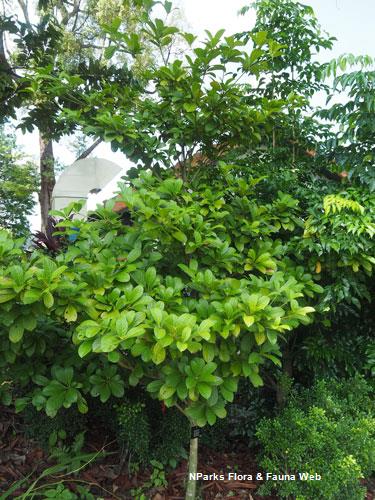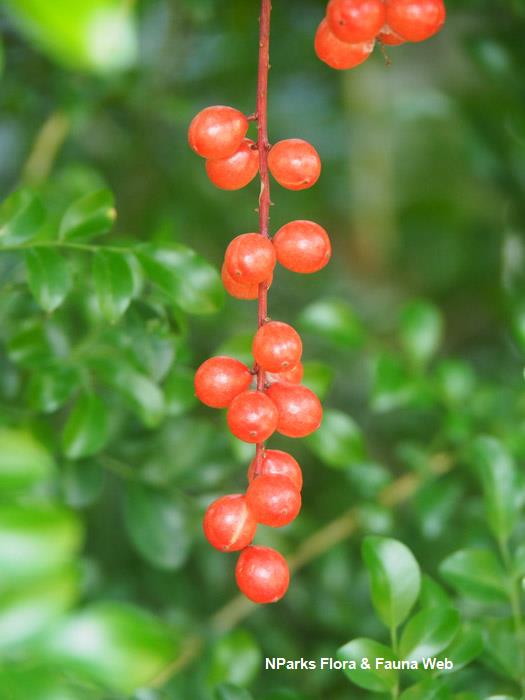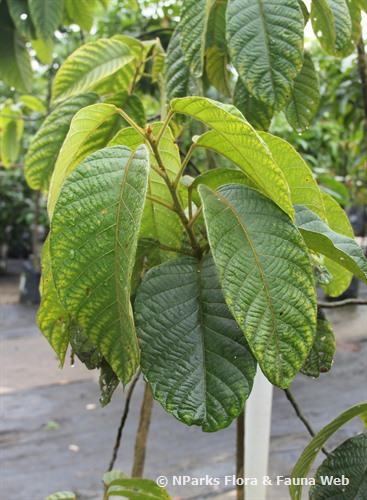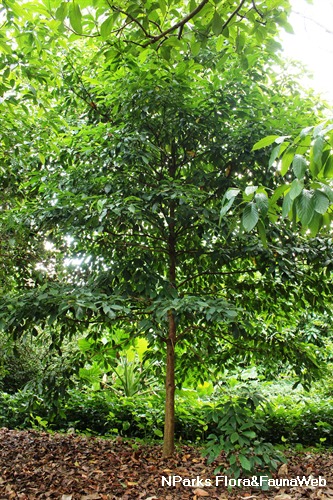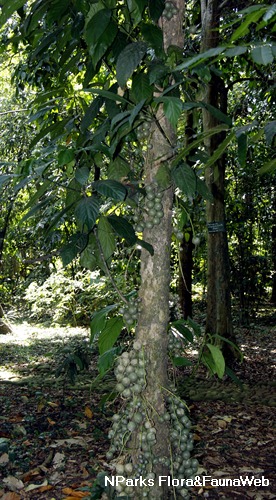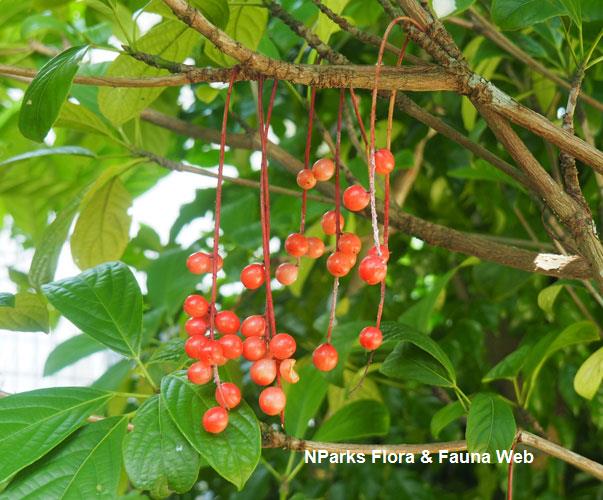
Back
Baccaurea tetrandra (Baill.) Müll.Arg.
| Family Name: | Phyllanthaceae |
| Synonyms: | Baccaurea stipulata J.J.Sm., Baccaurea terminalifolia Elmer, Baccaurea brevipedicellata Pax & K.Hoffm. |
| Common Name: | Kunau, Mata-pelandok |
Baccaurea tetrandra, also known as Kunau, is a tree that can reach up to 20 m tall. It produces fleshy red fruits which split open when mature. The seeds are surrounded by a layer of blue to purple pulp, which is edible and sweet- to sour-tasting.
Name
Classifications and Characteristics
| Plant Division | Angiosperms (Flowering Seed Plants) |
|---|---|
| Plant Growth Form | Tree |
| Lifespan (in Singapore) | Perennial |
| Mode of Nutrition | Autotrophic |
| Maximum Height | 20 m |
Biogeography
| Native Distribution | Borneo, Maluku, the Philippines and Sulawesi |
|---|---|
| Native Habitat | Terrestrial |
| Preferred Climate Zone | Tropical |
| Local Conservation Status | Non-native |
Description and Ethnobotany
| Growth Form | It is a tree, up to 20 m tall with candelabriform branching. The bark ranges from brown, grey to whitish green, and peels off in long strips, about 5 – 8 cm long. |
|---|---|
| Foliage | The leaves are obovate to elliptic, measuring (3.2 –) 5 – 21 cm long and 1.5 – 12.3 cm wide. They are spirally arranged and each leaf has (2–) 4 – 9 pairs of lateral veins. The leaf tip is pointed (ranging from obtuse to acute) and may extend up to 2 cm long, while the base is rounded to wedge-shaped (cuneate). The petiole is 0.4 – 7.5 cm long. The stipules fall off early, measuring about 0.3 – 1.1 cm long and 0.12 – 0.45 cm wide. |
| Flowers | The flowers are unisexual where male and female flowers are borne on separate plants (dioecious). They occur in branched clusters (thyrses) at the leaf axils. Male inflorescences measure 1.5 – 1.7 cm long and bear of 1 – 3 (– many) flowers. Male flowers are yellow to white, about 0.16 – 0.45 cm diameter, and have (3 or) 4 or 5 stamens. Female inflorescences are longer (2.5 – 30 cm long), and bear 1 – 3 flowers. Female flowers are yellow to green (to red), about 0.3 – 1.2 cm diameter, with a hairy globose ovary and a cleft stigma. Style is absent. |
| Fruit | The fruits occur in clusters on a stalk that can reach up to 45 cm long. They are globose to ellipsoid. These fleshy capsules, measuring 0.7 – 1.7 cm long and 0.65 – 1.5 cm wide), are red and split open at maturity. Each fruit contains 1 or 2 or 4 seeds within. The seeds are globose to obovoid and surrounded by a layer of blue to purple pulp (arillode). |
| Habitat | It is found in rainforests and swamp forests, up to 1500 m altitude. |
| Associated Fauna | Flowers are pollinated by insects. |
| Etymology | The genus epithet comprises of two parts. bacca, in Latin, means berry while aurea, in Latin, means golden, which refers to the golden coloured berries of some species in the genus. The specific epithet tetra, in Greek, means four or square. |
| Ethnobotanical Uses | Edible Plant Parts : Edible Fruits Food (Fruit or Vegetable): The pulp (arillode) is edible and sweet- to sour-tasting. |
Landscaping Features
| Landscape Uses | Parks & Gardens |
|---|
Fauna, Pollination and Dispersal
| Pollination Method(s) | Biotic (Fauna) |
|---|---|
| Seed or Spore Dispersal | Biotic (Fauna) |
Plant Care and Propagation
| Light Preference | Full Sun |
|---|---|
| Water Preference | Moderate Water |
| Plant Growth Rate | Moderate |
Foliar
| Mature Foliage Colour(s) | Green |
|---|---|
| Foliar Type | Simple / Unifoliate |
| Foliar Arrangement Along Stem | Spiral |
| Foliar Attachment to Stem | Petiolate |
| Foliar Margin | Entire |
| Foliar Apex - Tip | Obtuse, Acute |
| Foliar Base | Cuneate, Rounded / Obtuse |
Non - Foliar and Storage
| Trunk Type (Non Palm) | Woody |
|---|---|
| Root Type | Underground |
Floral (Angiosperm)
| Flower & Plant Sexuality | Unisexual Flowers , Dioecious |
| Flower Colour(s) | Cream / Off-White, Yellow / Golden, Red, Green |
|---|
| Flower Grouping | Cluster / Inflorescence |
| Flower Location | Axillary |
| Inflorescence Type | Thyrse |
Fruit, Seed and Spore
| Fruit Classification | Simple Fruit |
|---|---|
| Fruit Type | Dehiscent Dry Fruit , Capsule |
| Seed Quantity Per Fruit | Few (1-5) |
References
| References | Haegens, R.M.A.P. (2020). Baccaurea (Phyllanthaceae) In: Welzen, P.C. van (ed.). Flora Malesiana Euphorbiaceae. Naturalis Biodiversity Center, Leiden. (accessed 30 September 2025) |
|---|
Image Repository
Others
| Master ID | 33581 |
|---|---|
| Species ID | 7995 |
| Flora Disclaimer | The information in this website has been compiled from reliable sources, such as reference works on medicinal plants. It is not a substitute for medical advice or treatment and NParks does not purport to provide any medical advice. Readers should always consult his/her physician before using or consuming a plant for medicinal purposes. |


